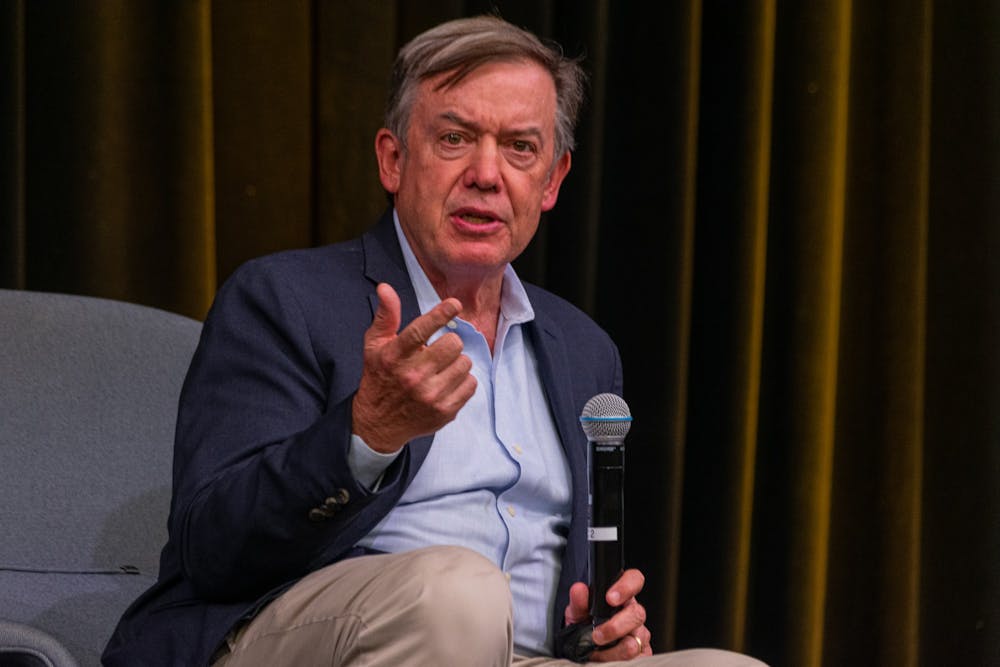When Michael Crow became the 16th president of ASU in 2002, Neil Giuliano, former mayor of Tempe from 1994 to 2004, saw the immense impact Crow could have not only on the University, but on Tempe and Arizona as a whole.
Giuliano worked with Crow before he came to Arizona, while the soon-to-be ASU president was still working at Columbia University. Giuliano worked as the director of federal and community relations at ASU before and during his tenure as mayor, and said he collaborated with Crow and his colleagues at Columbia.
In the 20 years since, other local and state leaders have, sometimes begrudgingly, seen the impact Crow has had on ASU and the communities it inhabits. He has integrated himself into nearly every facet of Arizona politics, cultivating relationships with most political entities in the state, from the city of Tempe and the Arizona Board of Regents, to the state Legislature and the governor’s office.
“He was seen as radical because higher ed hadn’t changed before,” said Mary Venezia, a student regent from NAU on ABOR during Crow’s early years at the University. “Now I think when we look back at those ideas that he had, he was really thinking way ahead of everyone else in the higher ed industry.”
From flip flops to five campuses
Early on, Crow formed an alliance with then-gubernatorial candidate Janet Napolitano to enact one of his many changes at ASU. She said the two met while she was distributing campaign flyers outside an AJ’s Fine Foods in Scottsdale. Crow approached the store in flip flops and shorts, she said. He and his wife were stocking up on groceries after just moving to Arizona and happened to run into Napolitano.
Shortly after, while still campaigning, Napolitano pledged to support Crow in his search for alternative funding methods for the University as the state suffered cuts to education funding.
“It was always a challenge at the Legislature particularly to get adequate funding for the state universities,” she said. “So we’ve worked together quite a bit on that. And then he reached out to city leaders and really, by working with the municipalities, got help that the state Legislature wouldn’t provide.”
Giuliano said lawmakers really began to see Crow’s drive in 2004, when Crow approached him and other local and state leaders about holding the third presidential debate between then-incumbent President George W. Bush and then-Sen. John Kerry on the Tempe campus. It was an ambitious undertaking for a University president so new to the state and its political inner workings, Giuliano said.
On Oct. 13, 2004, Crow and representatives of the Commission on Presidential Debates gave the opening remarks of the debate at Gammage Auditorium. According to State Press coverage at the time, 3,000 tickets were given out for the debate at Gammage, 300 of which went to students. 10,000 tickets were given to students for a viewing party at Wells Fargo Arena — now known as Desert Financial Arena — and other students participated in protests or rallies around campus.
By taking on the challenge of hosting a high-profile presidential debate, Crow let local and state lawmakers know he had large ambitions for the future of ASU, Giuliano said. So, when the University began expanding further into Tempe and other parts of the state in the years following, Giuliano wasn’t surprised.
ASU’s Downtown Phoenix campus broadened the University’s reach in 2006, followed by SkySong the ASU Scottsdale Innovation Center in 2008. By 2014, the University had opened ASU Colleges at Lake Havasu City. The expansion continued with ASU breaking ground on ASU at Mesa City Center in 2020.
The University even expanded outside of Arizona in 2013 and 2018, by opening facilities in Los Angeles and Washington, D.C., respectively. Although ASU had a presence in Washington since the early 2010s, it didn’t establish a D.C. headquarters until 2018.
“Most of us knew that the full aspiration of the University’s potential was not to be confined by the borders of the city of Tempe,” Giuliano said. “There’s a larger constituency, there’s a larger need in other parts of this region, for the University to serve the community, and to help educate the future of Arizona.”
Face off
Amid the early expansion of the University, Venezia was beginning her work as a student regent on ABOR. ABOR is the governing body that oversees Arizona’s three public universities. The board is made up of eight regents and two student regents — all of whom are appointed by the governor — and the current governor and superintendent of public instruction as two ex-officio members.
Working as a student regent demanded some butting of heads with Crow and the other university presidents, Venezia recalled. In 2008, she was working with the Arizona Students’ Association on a proposed tuition freeze that would offer fixed tuition to students at all state universities for four years, a proposal championed by Napolitano.
Crow has long been an opponent of tuition freezes. At a student forum in fall 2021, Crow said the University had only raised tuition about 2% over the last 10 years, making it cheaper than other Arizona universities like UA, which has a Guaranteed Tuition Program that freezes tuition for eight consecutive semesters.
Ultimately, the 2008 tuition freeze didn’t come to pass. But Venezia helped find a compromise by negotiating with the university presidents to keep tuition as low as possible.
Even though the tuition freeze initiative failed, Venezia said she gained a lot of respect for and insight from Crow while working at ABOR — inspiring her to continue working within higher education.
“A lot of the ideas that he brought to the board, and what ASU was doing, were seen as very different. Higher education in general hasn’t changed in forever,” Venezia said. “Michael Crow came in and was like, ‘Hey, let’s change this up. If there’s ways that we can be more efficient, we can support students better.’”
In the years since, Crow has gone toe-to-toe with regents on other issues. At a budget meeting in June 2021, Crow reminded the board of ASU’s independence from ABOR and state funding.
“We do serve the public and are governed by this board, but we operate in a modality where we seek partnerships, we seek revenue and mechanisms to generate revenue,” Crow said at the time.
Other public officials took issue with Crow and his out-of-the-box ideas, according to former regent Mark Killian, who served on the board from 2010 to 2015.
“Some people at the Legislature, sometimes the governors, get their nose out of joint because a university president is strident in their advocacy to protect universities and what they do,” Killian said.
In February 2022, Crow took a jab at state legislators during his State of the University presentation to ABOR, saying the University “failed at convincing the state to make investments in the public universities, at least our public universities at the level that we think is merited.”
Napolitano was one lawmaker Crow was said to have a tense relationship with. Despite their early alliance, the two clashed in the later years of Napolitano’s tenure over issues like the proposed tuition freeze, with rumors that Napolitano threw Crow out of her office at one point.
“We both have strong personalities,” Napolitano said. “And yeah, occasionally we had differences of opinion, and we always worked through them.”
Napolitano and Killian agreed that Crow always did what he thought was best for the University, even if that meant duking it out with Arizona’s top political players and government officials.
“The legislative process is adversarial and you have people with strong views on either side,” Killian said. “So you can get caught up in those disagreements, but I think what Michael has done has been perfectly appropriate.”
Despite the sometimes contentious relationships, current ABOR Chair Lyndel Manson said the regents have great respect for Crow and fully support his ambitions for the future of ASU. Manson said she admires Crow’s commitment to making higher education accessible, a goal outlined in ASU’s charter.
“He is very consistent with his message, he is very consistent with his efforts to increase attainment, to increase accessibility,” Manson said. “He walks the talk.”
Manson highlighted this and the University’s response to the COVID-19 pandemic as prime examples of Crow’s leadership. She called Crow’s lengthy tenure as ASU’s president “an incredible testament to his leadership” given that higher education leadership remain in their positions for less than a decade on average.
“And I certainly wouldn’t expect him to slow down,” Manson said. “I don’t think that’s in his personality.”
This story is part of "The Crow Issue," a State Press Magazine project looking back at the past 20 years of Michael Crow's tenure as University president. See the entire publication here.
Reach the reporter at rpriest2@asu.edu and follow @reaganspriest on Twitter.
Like The State Press on Facebook and follow @statepress on Twitter.

Reagan Priest is a managing editor, overseeing and working with the six digital desks at The State Press. She previously worked as a social justice reporter for Cronkite News and as a digital production intern at The Arizona Republic.





